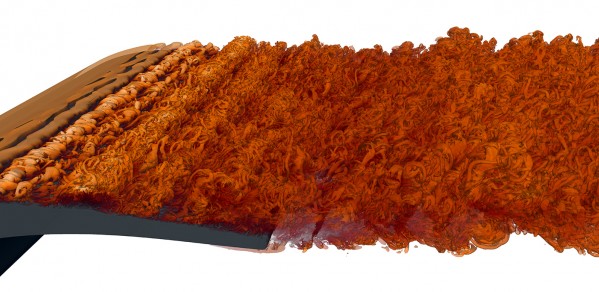
The project 'Stability and Sensitivity Methods for Industrial Design' (SSEMID), which finished in December 2019, received almost 4 million Euros from the European Union’s Horizon 2020 research and innovation programme.
It is remarkable that methods designed for aerofoil optimisation can be adapted to optimise the shape of an inkjet print head and, in another project, a vacuum cleaner.
Matthew Juniper, Professor of Thermofluid Dynamics
This European Training Network, which was embedded within the Marie Skłodowska-Curie actions, aimed to improve the aerodynamic performance of aeroplane wings. The flow around large aeroplane wings becomes turbulent, which increases drag. If this turbulence could be prevented, the drag would reduce by several percent, leading to significant fuel savings.
A familiar example of the difference between non-turbulent (laminar) flow and turbulent flow is the flow from a tap. Slow flow leads to a beautifully straight column of water, which is laminar and feels smooth. Faster flow leads to a jumbled column of water, which is turbulent and feels irregular. Over an aeroplane wing, the laminar flow reduces drag, while the turbulent flow increases drag.
The overarching goal of this project was to investigate transition to turbulence over a wing and to devise techniques to keep the flow laminar by changing the wing's shape. These techniques were also spun out into other applications, such as the design of inkjet print heads.
Matthew Juniper, Professor of Thermofluid Dynamics, and his team investigated stall behaviour of an aerofoil at high angle of attack, and used the same methods to design the optimum shape of an inkjet print head. Matthew Juniper commented: "It is remarkable that methods designed for aerofoil optimisation can be adapted to optimise the shape of an inkjet print head and, in another project, a vacuum cleaner."
Five Universities participated in the project, training sixteen early stage researchers. They were the Universidad Politécnica de Madrid (Spain), Imperial College London (UK), University of Cambridge (UK), KTH (Sweden), Katholieke Universiteit Leuven (Belgium), as well as three National Research agencies dedicated to aeronautic research: Office National d'Etudes et de Recherches Aerospatiales (France), Deutsches Zentrum für Luft – und Raumfahrt e.V. (Germany) and the Von Karman Institute (Belgium). The companies Airbus (UK) and NUMECA (Belgium) also employed researchers on the project and two American Universities participated: Purdue and San Diego University.
Over four years, the project contributed significantly to the development of numerical tools, the formulation of direct and adjoint methods for flow stability and the analysis of flow sensitivity under external perturbation. The project also progressed their application in the development of new industrial and more efficient aeronautical designs.
The young researchers employed by the project obtained their doctoral degrees within an international and intersectoral environment. They took an active part in the innovation process by developing new methodologies and incorporating immature technologies into the industrial design processes. Students were introduced to a global view of the aircraft design process: from understanding the mathematical basis of numerical methods for simulation in engineering to their industrial application. Participation in SSEMID allowed them to gain in depth understanding of problems associated with tunnel testing and industrial design and experience how the results of their research are directly influencing advances in the aeronautical and other industries.

